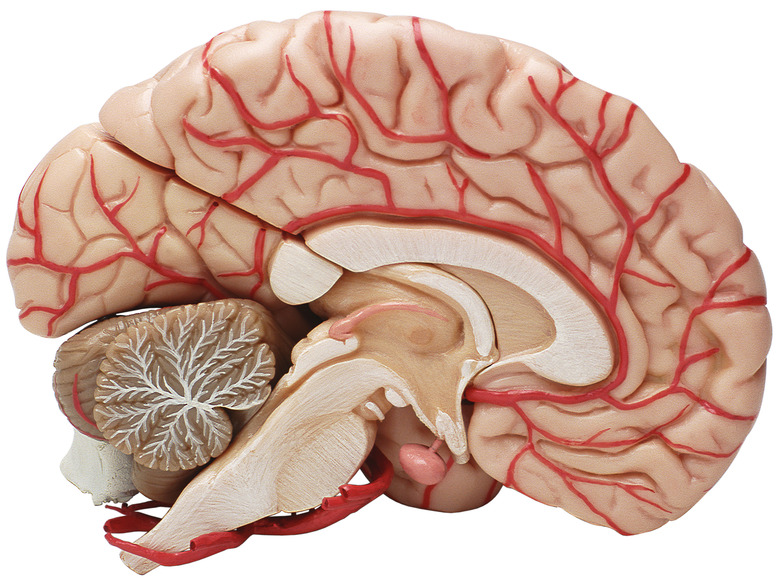An Easy Way To Learn The Cranial Nerves
Nerves, which are nervous tissues made up of neuron cells, are cells that transmit information across parts of our body and often to our brains. This information triggers bodily responses, help us "feel" certain senses and tell our bodies what to do. If you want to move your arm, it's nerves that carry the signal from your brain that says "move your arm" to the muscles in the arm that then move.
While the human body contains more than 1 billion neurons that form the spinal cord, brain and nerves, there are 12 pairs of nerves found arising directly from the brain (not the spinal cord, which is the origin point of many nerves). These 12 nerves are called cranial nerves and they serve as some of the most important nerves in the body, controlling movement, heart rate, senses and more.
Remembering the cranial nerves list is important for doctors and students alike. An easy way to remember cranial nerves is to remember their functions relate to their names and to create cranial nerve acronyms as mnemonic devices.
Types of Nerves and Neurons
Types of Nerves and Neurons
There are three general types of nerves:
1. Sensory 2. Motor 3. Relay
Sensory nerves and neurons respond to stimuli and carry a signal to the brain/spinal cord that tells you what you're sensing. They convert external stimuli (like light, sound, smell, taste, etc) into an electrical impulse that can be read and understood by your brain.
Motor nerves and neurons connect the brain to muscles and glands. They carry a signal to those muscles and glands and produce a response such as movement (aka motor function) or secretion of hormones, for example.
Relay nerves and neurons are responsible for transmitting, or relaying, information within the central nervous system. The could be sending signals to various parts of the brain or sending a signal from the brain to the spinal cord.
What Are the Cranial Nerves?
What Are the Cranial Nerves?
There are twelve pairs of cranial nerves with one of each pair found on both sides (left and right) of the brain.
**1. Olfactory Nerve.** This is a sensory nerve responsible for your sense of smell. It has receptors that detect smells and particles and transmits the information to your brain where the brain is responsible for scent recognition.
**2. Optic Nerve.** This is a sensory nerve responsible for your sense of sight. Light hits receptors in the eye that creates a signal that travels through the optic nerve to the brain where the brain deciphers what you're looking at.
**3. Oculomotor Nerve.** This is a motor nerve that helps you move your eye and focus on objects via pupil control.
**4. Trochlear Nerve.** This is also a motor neuron that aids in eye movement.
**5. Trigeminal Nerve.** This is the largest of the cranial nerves. It's both a sensory and a motor nerve and aids in sensory feelings like touch and pain in the face (cheeks, lips, scalp, eyelids, head, etc) and also has motor functions in the jaw and ear.
**6. Abducens Nerve.** This is a motor nerve responsible for eye movement.
**7. Facial Nerve.** This nerve has both sensory and motor functions for the face and gives you the sense of taste on your tongue, hearing senses in the ear, connecting to salivary and tear producing glands and moving muscles in the jaw/face.
**8. Vestibulocochlear Nerve.** This is a sensory nerve responsible for both your sense of hearing and your sense of balance.
**9. Glossopharyngeal Nerve.** This is both a motor and a sensory nerve responsible for sending sensory info to the sinuses, throat, ear and tongue. It also allows you to move muscles in the back of the throat.
**10. Vagus Nerve.** This is another motor and sensory nerve that is responsible for a wide range of functions including the sense of taste on the tongue, throat muscle control, ear canal senses, sending info to the heart and intestines and stimulating the movement of muscles in the digestive tract.
**11. Spinal Accessory Nerve.** This is a motor nerve that controls neck muscle movement.
**12. Hypoglossal Nerve.** This is a motor nerve that controls tongue movement.
Cranial Nerve Acronyms/Mnemonics
Cranial Nerve Acronyms/Mnemonics
An easy way to remember cranial nerves is to craft a mnemonic device that helps you remember the cranial nerves in order. One common example is, "Ooh, ooh, ooh to touch and feel very good velvet. Such heaven!" Each of the first letters in this mnemonic correlates to the first letter of the cranial nerve in the exact order of the nerves.
To remember whether the nerves are sensory nerves, motor nerves or have both, remember this mnemonic: "Some say marry money but my brother says big brains matter more". This assigns "s" to sensory, "m" to motor and "b" to both in the order of the cranial nerves.
For example, "money" starts with "m" meaning motor and it is the fourth word in the mnemonic, which means it corresponds to the fourth cranial nerve. The fourth cranial nerve is the trochlear nerve, which means that is a motor nerve.
Cite This Article
MLA
Walsh, Elliot. "An Easy Way To Learn The Cranial Nerves" sciencing.com, https://www.sciencing.com/easy-way-learn-cranial-nerves-6501174/. 31 July 2019.
APA
Walsh, Elliot. (2019, July 31). An Easy Way To Learn The Cranial Nerves. sciencing.com. Retrieved from https://www.sciencing.com/easy-way-learn-cranial-nerves-6501174/
Chicago
Walsh, Elliot. An Easy Way To Learn The Cranial Nerves last modified March 24, 2022. https://www.sciencing.com/easy-way-learn-cranial-nerves-6501174/
